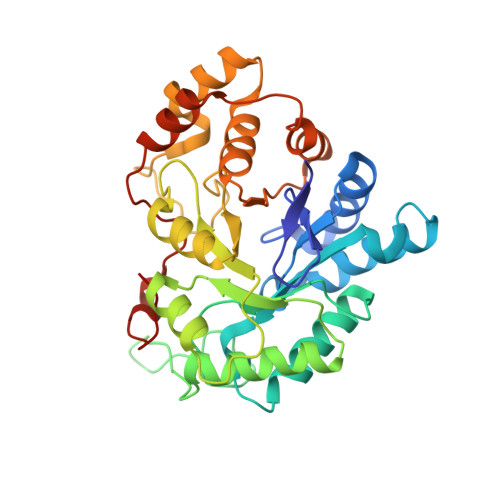Structural and Thermodynamic Study on Aldose Reductase: Nitro-substituted Inhibitors with Strong Enthalpic Binding Contribution
Steuber, H., Heine, A., Klebe, G.(2007) J Mol Biol 368: 618-638
- PubMed: 17368668
- DOI: https://doi.org/10.1016/j.jmb.2006.12.004
- Primary Citation of Related Structures:
2IKG, 2IKH, 2IKI, 2IKJ - PubMed Abstract:
To prevent diabetic complications derived from enhanced glucose flux via the polyol pathway the development of aldose reductase inhibitors (ARIs) has been established as a promising therapeutic concept. In order to identify novel lead compounds, a virtual screening (VS) was performed successfully suggesting carboxylate-type inhibitors of sub-micromolar to micromolar affinity. Here, we combine a structural characterization of the binding modes observed by X-ray crystallography with isothermal titration calorimetry (ITC) measurements providing insights into the driving forces of inhibitor binding, particularly of the first leads from VS. Characteristic features of this novel inhibitor type include a carboxylate head group connected via an alkyl spacer to a heteroaromatic moiety, which is linked to a further nitro-substituted aromatic portion. The crystal structures of two enzyme-inhibitor complexes have been determined at resolutions of 1.43 A and 1.55 A. Surprisingly, the carboxylic group of the most potent VS lead occupies the catalytic pocket differently compared to the interaction geometry observed in almost all other crystal structures with structurally related ligands and obtained under similar conditions, as an interstitial water molecule is picked up upon ligand binding. The nitro-aromatic moiety of both leads occupies the specificity pocket of the enzyme, however, adopting a different geometry compared to the docking prediction: unexpectedly, the nitro group binds to the bottom of the specificity pocket and provokes remarkable induced-fit adaptations. A peptide group located at the active site orients in such a way that H-bond formation to one nitro group oxygen atom is enabled, whereas a neighbouring tyrosine side-chain performs a slight rotation off from the binding cavity to accommodate the nitro group. Identically constituted ligands, lacking this nitro group, exhibit an affinity drop of one order of magnitude. In addition, thermodynamic data suggest a strongly favourable contribution to binding enthalpy in case the inhibitor is equipped with a nitro group at the corresponding position. To further investigate this phenomenon, we determined crystal structures and thermodynamic data of two similarly constituted IDD-type inhibitors addressing the specificity pocket with either a nitro or halogen-substituted aromatic moiety. As these data suggest, the nitro group provokes the enthalpic contribution, in addition to the H-bond mentioned above, by accepting two "non-classical" H-bonds donated by the aromatic tyrosine side-chain. In summary, this study provides the platform for further structure-guided design hypotheses of novel drug candidates with higher affinity and selectivity.
Organizational Affiliation:
Department of Pharmaceutical Chemistry, Philipps-University Marburg, Marbacher Weg 6, 35032 Marburg, Germany.
















